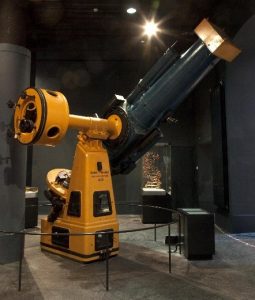Chambers St, Edinburgh, EH1 1JF

Royal Observatory Edinburgh’s 16/24-inch (0.4/0.6 m) Schmidt camerascope on display at National Museum of Scotland (© National Museum of Scotland)
The Astronomy Technology collections of the National Museum of Scotland contain a variety of artefacts, from orreys (mechanical solar system simulators) to a refracting imaging telescope. One of the larger artefacts on display is the Submillimetre Common-User Bolometer Array, or SCUBA, an instrument to take images of radio-frequency light emitted from dust in nearby galaxies. This red cylindrical device was installed at the James Clark Maxwell Telescope (JCMT) on Mauna Kea in Hawaii between 1997-2005 and produced some of the most impactful astronomy results at the time, surpassed only by the Hubble Space Telescope. This including significantly imporving the understanding of how galaxies are evolving and how new starts are being formed. One of the key partners in the consortium developing SCUBA, and its successor SCUBA-2, was the UK Astronomy Technology Centre, which is based at the Royal Observatory Edinburgh on Blackford Hill.
Find out more
- Reflecting and Refracting Telescopes – National Museum of Scotland
- UK ATC’s Page on SCUBA
- SCUBA’s Wikipedia Page

SCUBA mounted at JCMT at Mauna Kea (© Royal Observatory Edinburgh)

Sorry, the comment form is closed at this time.